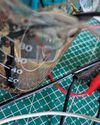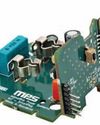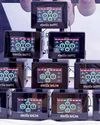The Exciting World Of GENERATIVE AI And ITS INTERACTIONS With The World Of FOSS
Electronics For You
|July 2023
Here's a primer on generative Al, thoughts on how you can empower yourself with this tech, and an insight into how Stable Diffusion has achieved success as an open source effort

Take a look at Fig. 1. Can you guess what these three images have in common? From a quick look, you may think that it's just the fantastical art style. What if I told you that none of them were drawn by a human artist but were generated on-the-fly within seconds by an Al model?
This is the power of generative AI-models capable of generating novel content based on a broad and abstract understanding of the world, driven by training over immense data sets. The 'artist' of the above images is a model named 'Stable Diffusion' released as open source software by the organisation Stability AI. All you have to give it is a text prompt de- scribing the image you want in detail, and it will do the rest for you. If you're curious, I've dropped example prompts that can generate the images in Fig. 2.
Stable Diffusion is not the first of its kind. OpenAI's 'DALL-E' beat it to the chase as it was released a few months prior. However, looking at the state of the art, it is the first generative AI model capable of image synthesis and manipulation that was released to the public as FOSS software while also being practical to adopt.
These models are not limited to images. The first generation (and possibly the most popular use case) of these models targets text generation, and sometimes more specifically code generation. Recent advances even include speech and music creation. Zooming out into a timeline with some of the major generative AI milestones (Fig. 3), we see that this technology has been out for a while, but only gained monumental traction recently.

This story is from the July 2023 edition of Electronics For You.
Subscribe to Magzter GOLD to access thousands of curated premium stories, and 10,000+ magazines and newspapers.
Already a subscriber? Sign In
MORE STORIES FROM Electronics For You

Electronics For You
Tech Majors Are Racing TOWARDS NET-ZERO - What About You?
Apple, Microsoft, Amazon, Google, Infosys, Wipro—global and Indian firms are heading closer to achieving net-zero emissions, a mandate to combat climate change. Here is what you need to know to start your journey...
12 mins
December 2025

Electronics For You
Miniature IoT WATER TDS And LEVEL MONITOR Cum CONTROLLER
For setups that rely on stored water, clear awareness of tank level and water quality is essential.
3 mins
December 2025

Electronics For You
The Impact Of GENERATIVE AI On The Future Of AUTOMOTIVE AND EVs
Autonomous vehicles, connected ecosystems, and smart factories are only the beginning. Generative Al is pushing the auto industry beyond predictions into a bold era of creativity-from EV design to real-time diagnostics and showroom automation. Here is how GenAl is reshaping innovation across the automotive value chain.
8 mins
December 2025

Electronics For You
How AI Tools Are Making SOFTWARE DEVELOPMENT BETTER
AI is reshaping how we code, debug, and collaborate. From Copilot to automation, it is changing software development in ways worth exploring.
3 mins
December 2025
Electronics For You
How AI Tools Are Making SOFTWARE DEVELOPMENT BETTER
AI is reshaping how we code, debug, and collaborate. From Copilot to automation, it is changing software development in ways worth exploring.
3 mins
December 2025

Electronics For You
5 Interesting Reference Designs FOR SMART HOMES
Smart home devices are transforming the way people interact with their appliances. They make homes more convenient, secure, and energy-efficient. From smart plugs and energy monitors to smart locks and thermostats, reference designs help design engineers create connected products that are easy to use, consume less power, and are reliable. These designs allow you to control devices remotely, track energy use, extend battery life, and automate routines. They provide practical solutions for upgrading homes and small commercial spaces without major modifications.
3 mins
December 2025

Electronics For You
Fancy USB LED VASE
This USB LED vase is a simple yet elegant device that fuses art with electronics to create a decorative lighting display. Powered directly from a standard USB port, it uses readily available components such as MOSFETs, resistors, capacitors, and LEDs to produce a striking, dynamic sequence of lights.
3 mins
December 2025

Electronics For You
"WHAT OTHERS SELL IN FOUR BOXES WE BUILT IN ONE"
Years of custom field work are shaping a product line with its own cloud, its own hardware, and a market that is now beginning to recognise its value.
8 mins
December 2025

Electronics For You
BUILD LARGE LANGUAGE MODELS
Large language models are machine learning models designed for a range of language-related tasks such as text generation and translation. Here’s how open source software can help you build your own large language model.
6 mins
December 2025

Electronics For You
Rare Earth Or Rare Ingenuity? India Remains Between The Two
With China firmly controlling rare earth exports, India confronts a critical moment in its technological trajectory.
8 mins
December 2025
Translate
Change font size

